Visitors to Covenant Cedars Bible Camp, north of Hordville, Nebraska, can witness an artifact of significance to the Swedish Methodists of Polk County. There the former Swede Plain church is preserved just inside the entrance to the camp as a monument to the immigrant pioneers and their determination to preserve their faith in the new land.
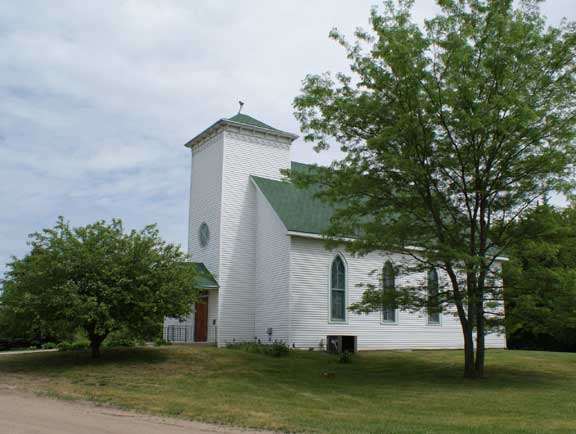
Swede Plain church at Covenant Cedars
Lennis Lind, a late member of this congregation, provided us with colorful stories about his own ancestors who founded this church and some insights into our own ancestors from the Polk area. He had retraced the steps of the Nordin (Norton) families to Victoria and Andover, Illinois, where they had lived before coming to Nebraska.
It is not necessary to be familiar with the whole state of Illinois in order to identify the points of origin for so many in Stromsburg. The corridor from Moline-Rock Island down to Galesburg, through Knox and Henry counties, contains these familiar names: Bishop Hill, Andover, Altona, Galva, Victoria, Knoxville and others. It's worth a look at the map. Varna, the point of departure for the Swede Home group, is about 50 miles east. New Sweden, Iowa, where many Stromsburg Baptists came from is slightly more distant to the west.
As we recall, these Nordins were among the L.P. Esbjörn party which came to Andover in the 1850's. While Esbjörn lay sick in Chicago, the group preceded him to Andover and many of the number were sidetracked to Victoria by the Methodist preacher, Jonas Hedstrom. In that early time, Lutheranism and Methodism were in heated competition. Apparently it was Nordin's mother-in-law, Mrs. Helena Hurtig, who took the initiative in Polk county to seek out a Methodist pastor to visit their new Nebraska community.
It is interesting to read E.W. Olson's account of Swedes in Illinois, where he mentions the Nordins and Hurtigs in the Andover section: "Hurtig's widow...in 1880 was residing in Polk County, Nebraska." (p.275) And, "Olof Nordin and his family also left shortly afterward and their fate is not known." (p.277) At Swede Plain, we find "the rest of the story."

C.O. Norton and his daughter, Nettie Carlson (aunt of Lennis Lind)
Nettie was a resident of Covenant Home during our time there
Pleasant Home is a precinct in Polk County west of Stromsburg. Before the railroad extended beyond Stromsburg, a community coalesced in Pleasant Home which included three churches within three miles. They were a Swedish Mission church (later moved to Polk), a Swedish Baptist church and the Swede Plain Methodists. Initially meeting in a sod house and later a school house built for dual purpose, Swede Plain was begun in 1874-5. The building preserved at Covenant Cedars was built in 1887 with a parsonage added in 1901. The organizing pastor was John Linn, then serving at Saronville down in Clay county. Mrs. Hurtig and the Nortons, the Swen Hokansons, the L.J. Johnsons, the L.P. Walbergs, the A.F. Wickstroms and the Peter Stenbergs joined the orginal class in 1876. We presume most or all of these were from Illinois. Linn will be familiar to readers of the Swede Bend story, where his surviving house and gravesite are pictured. In 1877, Rev. O.J. Swan assumed the Saronville charge and with it the task of ministering to both Swede Plain and the new Stromsburg congregation once a month. He received $5 per visit and boarded with the Nortons. He had previously been at New Sweden, Iowa, where he too changed his allegiance from Lutheranism (he had been a colporteur or travelling missionary in Sweden) to Methodism under the impetus of a Jonas Hedstrom visit to New Sweden. Other churches he served were: Swedona IL, Keokuk IA, Lindsborg KS, Oakland NE, and also was superintendant of the Kansas-Nebraska conference before becoming presiding elder of the Iowa district in 1893.
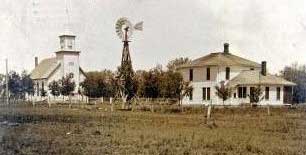
An early view of Swede Plain
(courtesy of C. Leypoldt)
Rev. Olin Swenson then became pastor, coming from the Evanston school. Members were added and the history recalls that he was the source of the name "Swede Plain." He would later serve the Oakland and West Hill congregations. The Evanston school had evolved through early locations in Galesburg and Galva, Illinois, familiar to Stromsburg founders. It would be interesting to know if any connections existed between the Galva and Stromsburg Methodists. (the writer received a degree from the successor school, Garrett Seminary) Some time later, J.B. Anderson was pastor and it was during his time that the church building was erected at a cost of $1,500. A significant effort of the church was the sponsorship along with Stromsburg of camp meetings.
During the years between 1905 until some time in the early 1920's the church sponsored and held each year what was called "Camp Meeting" in a grove along the Blue River about a mile south of Stromsburg. These meetings were held after harvest in the late summer and lasted for about two weeks. The meetings were held in a large tent with meetings for the children in the mornings and adult meetings in the afternoons and evenings. The local minister was in charge of services assisted by ministers from other Swedish churches and by local lay members. Some church members put up small tents and slept on the camp grounds, and there was a permanent dining hall building on the grounds where noon and evening meals were served during the meetings. Church members donated meats, vegetables, milk, eggs and other farm products which the women of the church cooked and served. These meetings were well attended. They not only provided inspiring worship experiences, but gave the opportunity for fellowship in visiting with those who came from other Swedish churches and other communities. (1976 Swede Plain Centennial book)

The Stromsburg camp meeting grounds
Prior to 1900, pastors lived in Stromsburg and served both churches. Among familiar names were J.A. Gabrielson (1879-80) who became president of the Kansas-Nebraska conference for four years and also served Galesburg, New Sweden, Keokuk, Des Moines, and West Hill. Rev. Gabrielson's wife is buried in the nearby Swede Plain cemetery. Add Harold Lindquist (1881-83) who also served Oakland and Red Oak/Essex in Iowa. With the passing of the Swedish language use in 1929, congregations such as Swede Plain became linked with English speaking congregations; the one in Polk specifically, later Stromsburg, and the era of our story must close.
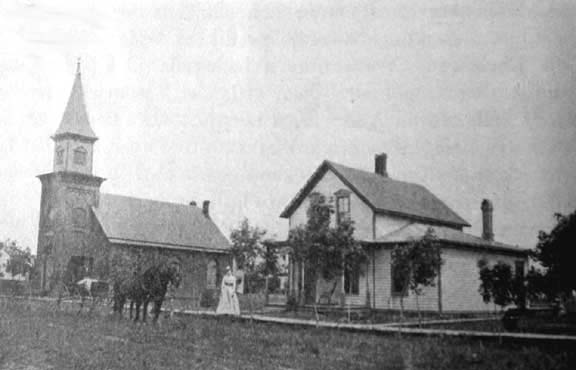
Could this be the proud Mrs. Simpson?
English speaking Methodists had been active in Polk County before the Swedes arrived. Mr. M.F. Barber was an early class leader, and John Dey served as a lay preacher meeting in the school and G.A.R. hall. In 1884 they built a church a block east of the Swedish Methodist church with a membership of around 25.
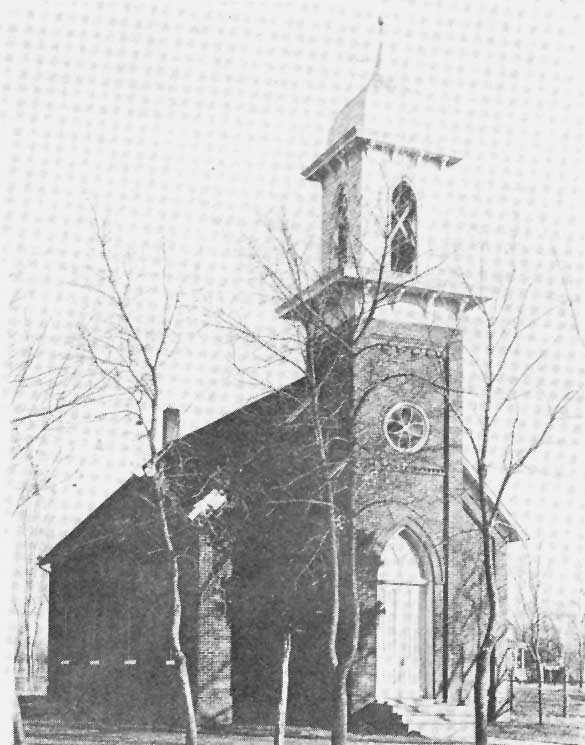
The "English" Methodist church
In 1920 a new Methodist church was built on the site of the Swedish church, which by 1975 had 370 members. It is assumed that the earlier English Methodist church had also been razed: its bell tower had previously failed.
In 1944, O.W. Strombom prepared a typewritten manuscript entitled "Historical Sketch of the work of Swedish Methodism in Nebraska." Thanks to C. Leypoldt, this source is available and the following is quoted:
Regarding the annals of the church at Stromsburg, they parallel those of Swede Plain so closely that it is needless to make a separate statement except in the matter of the building of the church and parsonage. The church in Stromsburg was erected in 1883 while John Simpson was pastor. A parsonage was built sometime later and is listed in the minutes of the first session of the Western Swedish Conference in 1894.
During the "Centenary Movement" a new English speaking church was to be built and as the corner upon which the Swedish building stood was considered the most appropriate location for this edifice the Swedes donated the lot and sold their building to Mr. 0. C. Danielson and A. B. Lind for $150.00. The building was razed and the proceeds of the sale were used to pay an old debt. The only stipulation made in the transfer of the lot was that the Swedish members were to be permitted to hold services in the newly erected (building) without payment of rent as long as there were enough of them left to desire these meetings. The Rev. E. R. Peterson was the last pastor of the Swede Plain Church to hold such meetings as the elderly people felt that the time had come to enter wholeheartedly into the program of the English speaking church.
The same pastors have served both churches, with a few exceptions, noteably in 1903 when A. F. Winell was appointed to Stromsburg, and Swede Plain had a separate pastor. Following him J. P. Norton became pastor in 1910. Both of these men served the St. Paul charge concurrently with the church at Stromsburg. Lincoln Valley and Gresham had also been outpoints from Stromsburg. The peak membership is listed as 110 with a Sunday School enrollment of 104.

Stromsburg Methodist Church today
Eric Forslund was Sunday School teacher in the Stromsburg Swedish Methodist church. He later served the same function for a long time in the Stromsburg Mission church, and still later did the same in the Stromsburg Free Mission church. He was a successful merchant, and in his home by the Blue River, my grandfather John Grönvall married Eric's wife's sister, Elizabeth. She died at a young age and is buried at Stromsburg.
Rev. Nordling of Swede Home seems not to be enthusiastic about what might be a competitive congregation in Stromsburg. It took local initiative by newcomers from Illinois and Lutheran farmers retiring to Stromsburg rather than to Swede Home to move things forward. Rev. G. Peters is in the struggling congregation at York, and he visits the Stromsburg Lutherans as does O.A. Johnson from Hordville.
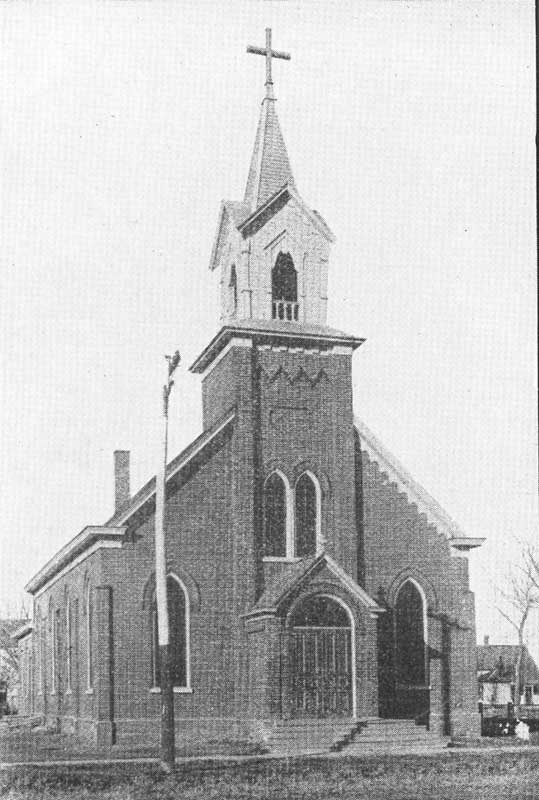
Stromsburg Salem Lutheran
32 members are mustered in 1888 to form the Salem congregation. By 1890 Salem had managed with the help of the new Nebraska Conference aid to build and dedicate a church. Students were assigned the charge, including C.A. Lonnquist who was to become its first stationed pastor. Lonnquist was to succeed K.G.W. Dahl as superintendant of Bethphage Mission at Axtell, and the writer has been delighted to discover that we have a distant relatedness through marriage.
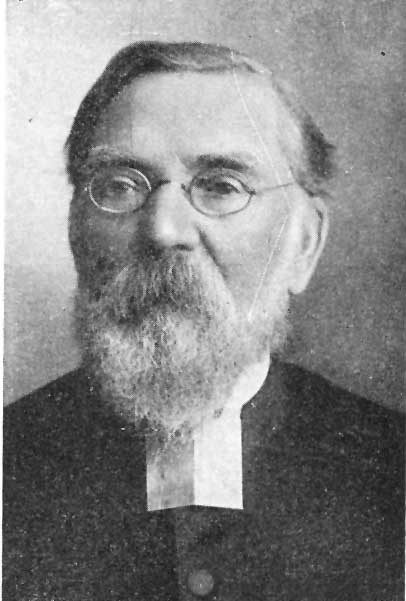

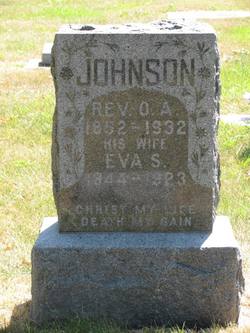
Rev. G. Peters, Rev. O.A. Johnson, and his grave at Swede Home
Sandahl expresses great admiration for both of these pioneers. Rev. G. Peters figures in the history of the Kearney Lutheran church story as well as in the Iowa Halland settlement. O.A. Johnson's name appears again and again, in Saunders County, up at Bristow, Hordville, at Bethphage Mission in Axtell and at Swede Home, his final resting place.

Salem Lutheran Church today
By 1931 when Sandahl writes, Salem is moving out of its assisted years and beginning to thrive as the picture of its present church building illustrates.
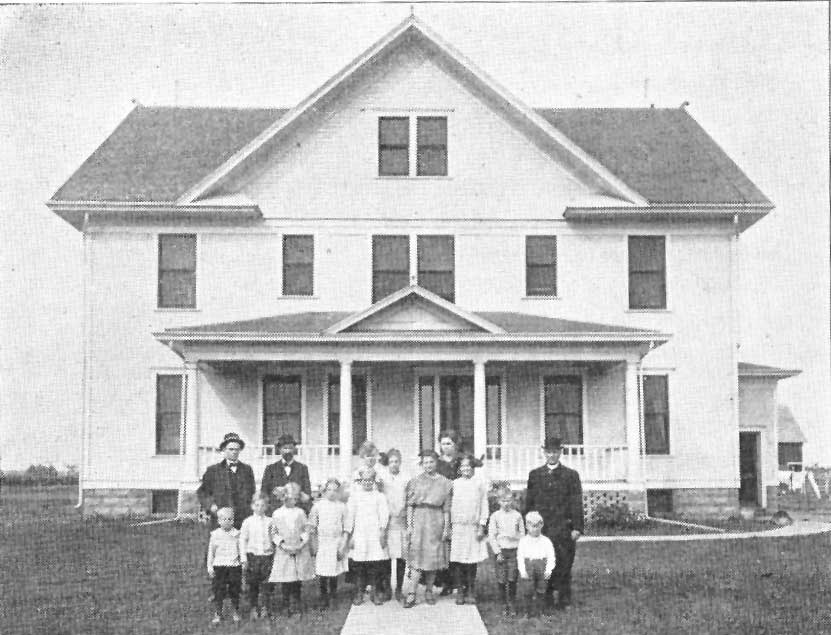
The Orphans' Home, later Covenant Home
In the course of time another Lutheran institution emerges in Stromsburg, the Conference Orphans' Home. This was built in 1912, but was overshadowed by the Augustana Synod's institution in Omaha and later absorbed by that body. Several decades later this home was purchased by the Covenant conference for use as a nursing home and still later was the place in which the writer served the best years of his ministry. The entire Stromsburg community strongly supports Midwest Covenant Home.

Midwest Covenant Home in recent years
For twenty wonderful years our family became intimately familiar with this place. Here we met the descendants of the pioneers described above and their churches. It has continued to grow and flourish...today the picture would be much improved. Now you know why Stromsburg is "dear to my heart".